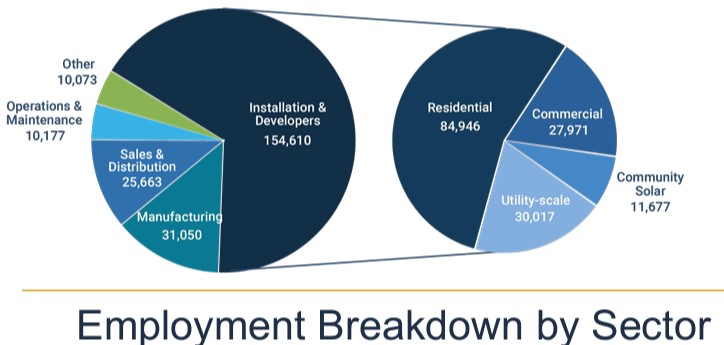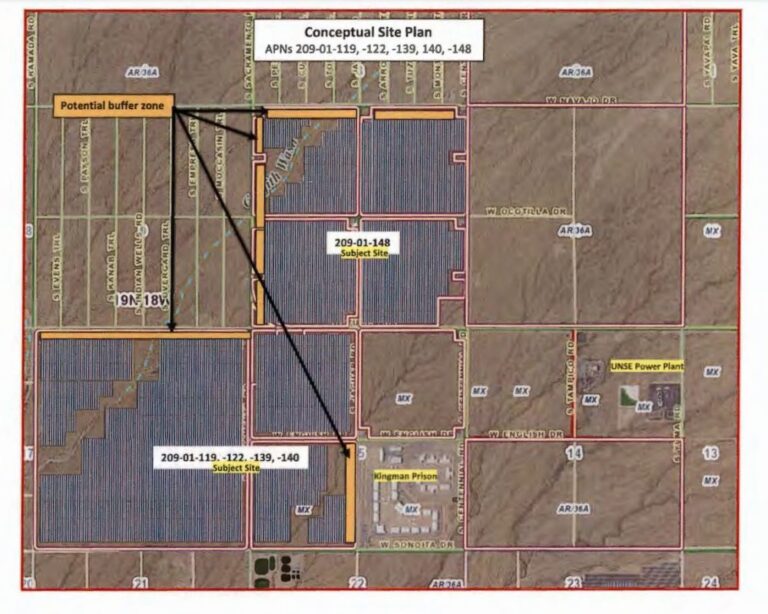By Roland Murphy for AZBEX
The Mohave County Planning and Zoning Commission has recommended approval for a solar overlay to enable a solar project of up to 200MW to move forward along Yucca Drive west of Continental Road near Griffith.
Owner/developer Greenstone Energy (Greenstone Capital) is developing the project through its affiliate Mysterious Island Development Co LLC. According to the Commission’s agenda packet, Mysterious Island Development is acting on behalf of Havasu Golden Valley, LLC and Western Progress Co.
The roughly 1,484-acre site is currently vacant. Surrounding land uses include another solar facility, a prison, industrial sites and more vacant land. The land is currently zoned for heavy industrial and agricultural residential with a 36-acre minimum lot size.
As required under Mohave County zoning regulations, Mysterious Island representatives scheduled a community meeting at the site on December 2nd of last year to discuss the project with residents and other concerned citizens and groups. No one attended.
Design and construction teams for the project have not been announced yet. Development documents submitted to the County show Mysterious Island intends to begin applying for building permits late this year or early in 2023. If all approvals and permits go as planned, construction should start in 2023, with delivery expected mid-2024.
A Brief Look at U.S. Solar
For all the undisputable benefits of a diversified array of sources making up the energy infrastructure mix, there remains a great deal of confusion in the general public about the labor market impacts of alternative energy sources, particularly solar. In promoting the recent infrastructure and social spending bills, countless ads were run nationwide touting the “millions of clean energy jobs” the various proposals would provide.
That is accurate, but incomplete. While the construction market would benefit greatly, the ongoing market would not see nearly the same impact. Solar advocates generally cite approximately two-thirds of solar jobs as coming in the construction and development cycle, while traditional energy adherents claim a ratio as high as 10-to-1 for construction versus operations and maintenance jobs.
Because solar and other forms of alternative energy have been coopted into the ongoing larger right vs. left political debate, objective data on job and economic impacts are hard to come by. As just one example, a solar jobs census published by The Solar Foundation reported 260,077 solar jobs in 2016. It also noted the Bureau of Labor Statistics’ Standard Occupational Classification listed only 11,300 workers in its “Solar Photovoltaic Installer” category.

As a non-profit solar energy advocacy group, The Solar Foundation has an obvious bias, but its data generally holds up to scrutiny. In a 2018 opinion piece in The Hill, which is generally regarded as a centrist news outlet, Solar Foundation President Andrea Leucke called the BLS data “incomplete and highly problematic,” in part because, “The BLS defines ‘Solar Photovoltaic Installers’ very narrowly. For example, their definition does not include electricians, supervisors, or construction laborers working on solar sites. These occupations are all identified with separate occupational classification codes, regardless of whether they work on solar installation sites.”
In the years since, largely due to the pandemic, the solar jobs census shows solar employment has fallen from its 2016 peak, reporting 231,474 workers in the industry in the 2020 solar jobs census. Of those, 67% of solar employment was in the Installation and Construction Segment.
Solar in Arizona
Averaging 299 sunny or mostly sunny days per year, Arizona’s abundant sunshine and comparatively cloudless climate has made the state an obvious target market for solar energy development for decades. In the last 20 years, as the drive for alternative energy and reduced carbon emissions has gathered global momentum, development has increased, and in the last decade solar projects have begun to spring up with exceptional frequency.
FP P&D Mysterious Island Solar Capacity 
DATABEX has listed 55 solar and directly related projects since its launch in 2016.
Please note that for this article we have excluded small scale projects, such as cities and companies adding solar panels to buildings and parking canopies, and battery-storage-only projects. Where a project has both a solar power and battery storage component, we have tried to include only the solar energy portion.
Those 55 projects add up to at least 12,045MW of new solar energy planned across the state in the last five-plus years. Of those, nine have been canceled for various reasons, taking 1,759MW out of potential play. Another 150MW project is currently noted as being on hold, however it may resume in the near future. Since DATABEX launched, 10 projects have completed, adding 1,585MW to the grid. Four more projects of 531MW total are actively under construction.

Unfortunately, construction cost estimates are only available for 35 of the 55 projects listed, which account for 6,552MW in the total project list. The estimates for those 35 add up to slightly more than $14.475B, yielding an extremely rough ballpark average estimated construction cost of $2.2M/MW. If that ballpark were to hold true universally across the 55 projects, the total estimated construction value in the current Arizona market would be $26.6B.
The official estimate for construction costs published by the U.S. Department of Energy’s Energy Information Administration is not far off from that estimate. As of 2018, EIA estimates a cost of $1,848/KW. Converting Arizona’s 12,045MW to KW provides a total of 12,045,000 or $22.26B in construction costs for all proposed projects since 2016.
Given the comparative inefficiency of solar versus fossil fuels in terms of energy output volumes – +/-220MW/project for Arizona solar projects vs. an average of 600MW/U.S. coal plant – solar had long been dismissed as a niche, “feel good” solution offering more effective benefit for public relations and social agendas than for the actual energy grid or the overall economy.
As the efficiency of solar energy delivery and storage increase, and as the volume of projects proposed and delivered both in Arizona and the nation expand, not even the most ardent naysayers can hold on to that argument as anything more than an article of faith.
BEX Administrator Monica Tapia contributed to the research for this article.


1 Comment
Sorry we missed the meeting in December in Kingman,AZ. Just now saw the post on my phone. We are happy to hear your company is working to bring solar to kingman and Golden Valley,AZ. We live off the grid and use a Generator for Electric, so being able to finally have Electric would be a Blessing and more people would move to Golden Valley. Praying this happens soon. Thank You Kurk.